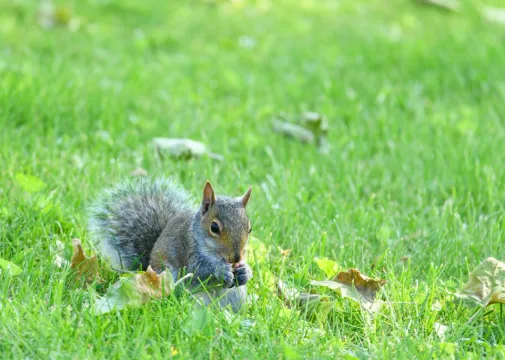The English Squirrel: A Small Rodent with a Big Impact

When we think of British wildlife, the squirrel is one of the first animals that comes to mind. Easily spotted in parks and gardens across the UK, it charms with its liveliness, agility, and small size. Yet behind its pretty face lies a complex history, marked by the introduction of a foreign species, struggles for survival, and conservation efforts.
In this blog, let's discover together who the English squirrel is, what its characteristics are, its history and its impact on the British environment.
Two main species in the UK
We often talk about the English squirrel, but in reality, there are two species of squirrel that coexist (more or less peacefully) on British territory:
- Red squirrel (Sciurus vulgaris)
Native to Europe, this squirrel is the only one native to the United Kingdom. Its fur is red, sometimes slightly brown or gray in winter, and its long ears are adorned with characteristic tufts of hair. It is an iconic animal of the country, particularly in Scotland and some rural areas of northern England.
- The gray squirrel (Sciurus carolinensis)
Introduced from North America in the late 19th century, this gray squirrel has become the dominant species in England, to the detriment of the red squirrel. It is larger, more robust, and better adapted to urban life and human-modified environments.
A story of accidental conquest
The history of the English squirrel took a decisive turn in 1876, when the first gray squirrels were introduced to England by aristocrats as decorative ornaments on their estates. Little did they know that these charming rodents would quickly reproduce, colonize forests and towns, and directly threaten the existence of the red squirrel.
Today, the grey squirrel is found throughout most of England and Wales, while the red squirrel takes refuge in protected and isolated areas.
Why is the gray squirrel a threat?
The gray squirrel is not just a competitor. It represents a real ecological threat to the red squirrel, for several reasons:
- Food competition: more aggressive, it monopolizes resources such as acorns and hazelnuts.
- Disease Transmission: The gray squirrel is a healthy carrier of a virus called parapox , which is fatal to red squirrels.
- Adaptability: It adapts better to urban environments and tolerates climatic variations more easily.
As a result, since the arrival of the grey squirrel, red squirrel populations have fallen by more than 90% in England.
Conservation efforts to save the redhead
Faced with this dramatic decline, several nature protection organizations (such as the Red Squirrel Survival Trust or the Wildlife Trust) have implemented conservation strategies:
- Creation of grey squirrel-free zones, particularly on islands (such as Brownsea Island) or in certain forests in Scotland.
- Selective gray hair eradication programs (controversial, but sometimes necessary).
- Public awareness campaigns to protect redhead habitats.
- Winter feeding and setting up specific feeders that the grays cannot use.
The English squirrel in popular culture
The squirrel, and more specifically the red squirrel, occupies an important place in British culture. It can be found in:
- Children's stories, such as Squirrel Nutkin by Beatrix Potter.
- Logos of ecological companies or associations.
- Advertisements, as a symbol of liveliness, of savings (like the famous "squirrel" of French banks).
It is also a popular subject for amateur photographers and walkers in London's parks, such as Hyde Park, Regent's Park or St James's Park, where grey squirrels sometimes come to eat from visitors' hands.
The English squirrel and urban ecology
The gray squirrel's success is also linked to its relationship with humans. In English cities, it has taken advantage of ornamental trees, food waste, and bird feeders to thrive.
But this cohabitation sometimes poses problems:
- It can damage trees by gnawing the bark.
- It sometimes enters the attics of houses.
- It can disrupt the local ecological balance by eliminating other species.
Municipal authorities are therefore trying to manage its population without harming the animal, which remains popular with the public .
A challenge for British biodiversity
The situation of squirrels in England illustrates a wider problem: that of invasive species and ecological imbalances caused by human introductions.
Protecting the red squirrel means defending:
- A native species thousands of years old.
- A fragile natural balance, threatened by man.
- A strong symbol of identity, particularly in Scotland, where red hair is still the majority.
What to do at your level?
If you are visiting or living in the UK, here are some simple steps you can take to protect red squirrels:
- Do not feed gray squirrels.
- Support wildlife protection associations.
- Install selective feeders for redheads.
- Report any red squirrel sightings in your area.
Conclusion: Small animal, big stakes
The English squirrel, and more specifically the gray squirrel, perfectly illustrates how an introduced species can disrupt an entire ecosystem. Behind its endearing image, it embodies the tensions between biodiversity, urbanization, and human choices.
But the story isn't over yet. Thanks to the combined efforts of naturalists, associations, and citizens, the redhead lives on, carrying a memory, a living heritage, and a powerful message: every species matters.